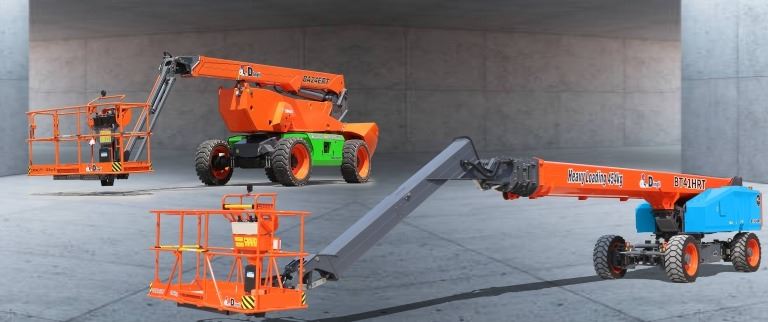October 17,2024
How Electric and Hybrid Aerial Work Platforms Are Revolutionizing Construction Site Operations

In recent years, industries across the globe have undergone a notable transformation, with a strong emphasis on sustainability and efficiency. One of the most impactful changes is the rise of electric and hybrid Mobile Elevated Work Platforms (MEWPs), also known as Aerial Work Platforms (AWPs). These machines have transformed construction sites' operations, offering eco-friendly, quieter, and cost-effective solutions. In this blog, we'll explore the key benefits of electric and hybrid AWPs and how they're revolutionizing construction.
1. Why the Shift to Electric and Hybrid AWPs?
Industries traditionally rely on diesel- or gas-powered equipment, which has environmental drawbacks. However, it is under increasing pressure to adopt greener technologies due to regulatory changes and a growing focus on sustainability. This has driven the shift towards electric and hybrid AWPs, which offer various advantages over their traditional counterparts.
2. Eco-Friendly Operations: Reducing Carbon Footprint
Electric and hybrid AWPs are designed to reduce harmful emissions, making them an eco-friendlier alternative. Here's why:
● Zero Emissions: Electric AWPs produce no exhaust emissions, making them ideal for indoor projects or areas with strict environmental regulations.
● Reduced Fuel Consumption: Hybrid models can switch between electric and diesel power, significantly lowering fuel consumption when operating in electric mode.
● Compliance with Regulations: As more countries impose stricter emission standards, electric and hybrid AWPs help construction companies meet environmental regulations without compromising performance.
By choosing electric or hybrid AWPs, companies can significantly reduce their carbon footprint, contributing to a greener tomorrow.
3. Quiet Operation: Minimizing Noise Pollution on Site
Noise pollution is a growing concern in urban construction environments, where work often occurs near residential areas, schools, or hospitals. Traditional diesel-powered AWPs contribute to high noise levels, disrupting communities and requiring limited working hours. Electric and hybrid AWPs, however, offer a quieter solution:
● Silent Operation: Electric AWPs operate almost silently, allowing construction projects to continue without disturbing surrounding areas.
● Extended Working Hours: Due to their quiet performance, electric AWPs can be used during early mornings or late evenings, extending the available working hours on time-sensitive projects.
● Improved Worker Safety: Lower noise levels on-site enhance worker communication, improving safety and overall productivity.
This reduction in noise pollution not only improves the environment for nearby communities but also enhances the safety and comfort of construction workers.
4. Lower Maintenance Needs: Reducing Downtime and Costs
One of the most significant advantages of electric and hybrid AWPs is their reduced need for maintenance. Diesel engines require frequent servicing, resulting in increased downtime and maintenance costs. In contrast:
● Fewer Moving Parts: Electric AWPs have fewer moving parts than diesel engines, leading to less wear and tear and fewer breakdowns.
● Extended Lifespan of Components: Electric motors and batteries are designed to last longer, reducing the frequency of replacements and repairs.
● Simplified Maintenance: Hybrid models, combining diesel and electric systems, often operate on electric power for long durations, reducing engine hours and the associated maintenance needs.
By reducing maintenance requirements, companies can experience less downtime, lower operational costs, and improved project timelines.
5. Enhanced Productivity and Efficiency on Site
Electric and hybrid AWPs are not just eco-friendly; they're also designed to enhance productivity. Here's how they boost efficiency on construction sites:
● Instant Start-Up: Electric AWPs require no warm-up time, allowing operators to get to work immediately increasing productivity.
● Precise Control: These AWPs offer smoother and more precise control over positioning, improving safety and accuracy in high-reach operations.
● Increased Uptime: Electric and hybrid AWPs tend to have higher uptime than traditional models, with fewer mechanical issues and a more efficient power source.
The enhanced efficiency of electric and hybrid AWPs can lead to faster project completion times and a more streamlined construction process.
6. Ideal for Indoor and Outdoor Use
Electric and hybrid AWPs are versatile and can be used for both indoor and outdoor applications, making them suitable for a variety of projects:
● Indoor Use: Electric AWPs produce zero emissions and minimal noise, ideal for indoor environments such as warehouses, shopping malls, and industrial facilities.
● Outdoor Use: Hybrid AWPs are perfect for outdoor projects, where they can switch to diesel power if needed. This flexibility allows them to work in remote areas without access to electric charging points while benefiting from lower emissions during parts of the project.
7. Cost Savings and Return on Investment (ROI)
While electric and hybrid AWPs may have a higher initial purchase cost, they offer long-term cost savings, making them a wise investment for companies. Critical areas of cost savings include:
● Reduced Fuel Costs: Hybrid models consume less fuel, while electric AWPs eliminate fuel costs, lowering operational expenses.
● Lower Maintenance Costs: Fewer mechanical parts and lower maintenance needs result in reduced repair costs and longer intervals between servicing.
● Extended Equipment Lifespan: Electric and hybrid AWPs often have a longer lifespan due to fewer moving parts and better durability, increasing their return on investment (ROI).
Electric and hybrid AWPs are cost-effective for construction companies because they offer long-term savings on fuel, maintenance, and equipment replacement.
Conclusion: The Future of AWPs in Construction
As construction sites continue to evolve, adopting innovative technologies like electric and hybrid AWPs will be critical for staying competitive. These platforms offer a glimpse into the future, where sustainability, efficiency, and safety are prioritized. Construction companies that embrace this shift will contribute to a greener environment and benefit from cost savings, increased productivity, and compliance with stringent regulations.